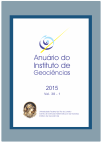High Spatial Resolution Images of Unmanned Aerial Vehicle (UAV) in Land Use and Occupancy Planning
DOI:
https://doi.org/10.11137/2015_1_147_156Keywords:
Permanent Preservation Areas, Plan for Recovery of degraded Areas, DRONEAbstract
The creation, improving and use of remote sensing techniques focused on suborbital images are increasing, as they present several advantages in geographical and ecological analysis, producing high spatial resolution data. The aim of this work was to test the supervised and unspervised classification techniques in aerial digital images with high spatial resolution obtained by Unmanned Aerial Vehicle (UAV), using the softwares SPRING and ArcGis. The aerial images have spatial resolution in approximately 10 cm, covering around 45% of the floor area. They were obtained in June, 2011, and overlies a stretch of the headwaters of the São Lourenço river in Campo Verde, Mato Grosso. Th aerial photographs were georeferenced and then the classification tests were performed, which presented better results the ones by region. At this stage, about 100 segmentation tests were performed with distinguished similarity parameters and areas, until finding a routine that would fit better to the study area. The classification that better delimited the different features present in the images was the supervised by region, whose segmentation had 20 pixels of similarity and 200 of area. To prove statistically the efficiency of classification, a cluster test was performed and the validation was done through Kappa index and overall accuracy. The presented results along with the use of UAVs are great tools and liable to use in several areas, including environmental expertising routines and recovery of degraded areas monitoring, under the Brazilian Forest Code.Downloads
Download data is not yet available.
Downloads
Published
2017-02-15
How to Cite
Cândido, A. K. A. A., Silva, N. M. da and Paranhos Filho, A. C. (2017) “High Spatial Resolution Images of Unmanned Aerial Vehicle (UAV) in Land Use and Occupancy Planning”, Anuário do Instituto de Geociências. Rio de Janeiro, BR, 38(1), pp. 147–156. doi: 10.11137/2015_1_147_156.
Issue
Section
Article
License
This journal is licensed under a Creative Commons — Attribution 4.0 International — CC BY 4.0, which permits use, distribution and reproduction in any medium, provided the original work is properly cited.















